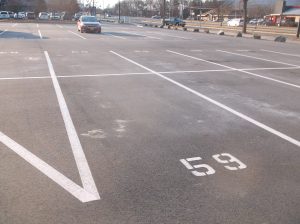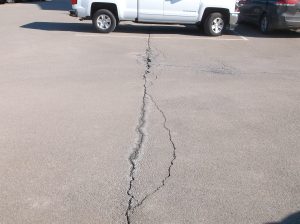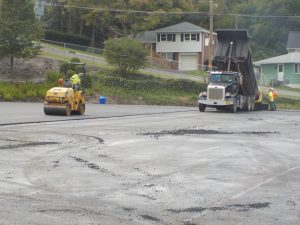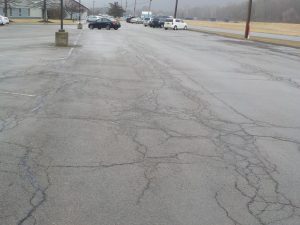 By Troy Kaiser
By Troy Kaiser
Senior Consultant
The key to improving overall condition of your asphalt and concrete pavements and reducing the long-term costs associated with rehabilitating those pavements is prioritization. Your pavements may include parking lots, roadways or driveways, dock areas, dumpster areas, and walkways. To properly prioritize your pavements, you have to get “boots on the ground” and walk areas to collect critical information needed to make informed decisions. Evaluating your pavements is the first step in organizing them into distinct groups.
One approach includes prioritizing pavements into three different classifications:
- Above average to very good condition – fairly new pavements requiring no or only preventive maintenance repairs such as cracksealing, jointsealing, and isolated patching.
- Average to fair condition – pavements requiring more than just basic maintenance, but can be saved through the use of more extensive means, such as a structural overlay.
- Poor to very poor condition – pavements approaching the end of their life cycle and money spent for anything other than safety issues would be wasted.

Funds should be allocated to maintain newer pavements first. This projects the investment by extending serviceable life of the pavement.
When it comes to assembling pavement budgets, it is human nature to give pavements in poor condition the highest priority. In the pavement industry, we refer to this as the “fireman approach” because it is akin to putting out fires as they break out without taking steps to prevent them. The correct approach is to invest in your above average to very good pavements, followed by average to fair and then invest in the poor to very poor.
By performing preventive maintenance and repairs on your above average to very good pavement, you prevent premature deterioration. This type of expenditure is the least expensive and the most cost-effective use of your budget. This strategy not only protects the initial investment in the construction of the pavement but extends its life as well. These pavements will remain in the first group with continued commitment to routine maintenance.
The next priority for spending should be pavements in the second group, average to fair. These pavements may not have been properly maintained, or maybe they have been but are older pavements. These pavements are still in good enough condition that it is prudent to invest funds on a structural improvement (such as an overlay) since it will extend the life of the pavements for another 8 to 10 years or more. Once improvements are completed, these pavements will be moved to the first group, above average to very good, where routine maintenance will keep them in maintainable condition for additional years to come.

Repairing isolated failures before they spread will extend the life of a good pavement and delay the need for costly reconstructions.

Placing a structural overlay at the right time will extend the life of the pavement and delay a more expensive reconstruction.

In general, delaying work a year or two does not increase the cost to reconstruct a pavement that is already in poor condition, but serviceability and safety need to be evaluated and considered.
Investing money on the third classification of pavements, poor to very poor, should be your last priority. These pavements are not good candidates for structural enhancements such as overlays since that would not significantly extend the life of the pavements. Further, performing preventive maintenance on these pavements would also be an ineffective use of funds. The only course of action to properly improve these pavements is either full or partial depth reconstruction. Fortunately, once pavements reach this point, the cost to do the reconstruction does not change much if you have to delay work for a few years. Also, pavements considered to be in need of reconstruction are generally still serviceable depending upon usage and overall condition. Of course, you should invest money on these pavements as needed to take care of any safety issues until they can be reconstructed.
Following this program as outlined will result in: (1) Maintaining your newer pavements at their current condition, getting the most out of the recent investment, (2) improving and maintaining salvageable pavements while underlying structure is still sound, and (3) eventually reconstructing and restoring your worst pavements. Following this strategy to prioritize pavements into these three classifications and then investing in the better pavements first will, over time, result in overall improvement of your pavement asset portfolio and reduce future pavement costs.
